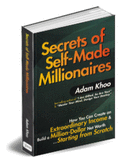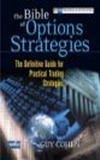My Trading Style (Part 3)
Part 1, Part 2
When I come across potential candidates to trade, I will first zoom in on the potential room for movement. If the potential move is less than $1, I pass. Why? Because options trading is a different playing field from stocks. Let me give a simple illustration here. I've mentioned that I like to buy ITM options, having a delta of 0.5-1.0. So assume the following:
->Stock moves in your direction by +$1
->Delta @ 0.6. For every $1 move on the stock price, the option price moves by $0.6.
->Slippage of $0.2 for a round trip (which is very common)
=> Net(before commission) :+$0.4
And this is also assuming that IV doesn't go against you during this period and ignoring time decay. Now consider the risk you are taking on....you get the picture now? In stock trading, you don't need to consider factors like delta, IV, time decay. A $1 move on the stock price is a $1 gain (excluding commission). You will also realise that a $0.2 slippage as a % of option price of say $4.0 is far greater than as a % of stock price of say $50. No wonder Bernie Schaeffer said in his book, The Options Advisor, that many options traders fail because they trade options like stocks.
In terms of technical analysis, I'm currently mainly using indicators like Moving Averages and Fibonacci. Sometimes, I also look at Bollinger Bands (BB), RSI, ADX, MACD and Slow Stochastic. You can find out more about these indicators very easily, and Investopedia is a good place to start with.
My first mentor is a non-believer in technical analysis (T.A.) because he believes that T.A. reflects something of the past and stocks are only driven by news going forward. However, overtime and through my second mentor, I found T.A. to be very useful in helping me to determine resistance & support and hence determining entry & exit. These indicators are now an integral part of my trading. I'm not refuting the teachings of my first mentor, because news does really have its place in trading. Well, my VTS straddle trade is a living proof that news does matter. News such as earnings release, FDA approval, M&A etc are important and we need to know when such events are happening, especially if you are a swing trader. The last thing you want is to enter a swing trade and the next day it gaps in the opposite direction by 50%! due to some pending FDA approval or earnings report. Speaking of which I avoid holding overnight positions in energy sector & pharmaceutical sector as they are highly volatile.
Well, I've always feel that there is no one trading strategy that is superior than another. Its all about finding a trading style that suits yourself. In the next part, I'll share my thoughts on the 3Ms of trading: Mind, Money Management and Method. To be con't...
When I come across potential candidates to trade, I will first zoom in on the potential room for movement. If the potential move is less than $1, I pass. Why? Because options trading is a different playing field from stocks. Let me give a simple illustration here. I've mentioned that I like to buy ITM options, having a delta of 0.5-1.0. So assume the following:
->Stock moves in your direction by +$1
->Delta @ 0.6. For every $1 move on the stock price, the option price moves by $0.6.
->Slippage of $0.2 for a round trip (which is very common)
=> Net(before commission) :+$0.4
And this is also assuming that IV doesn't go against you during this period and ignoring time decay. Now consider the risk you are taking on....you get the picture now? In stock trading, you don't need to consider factors like delta, IV, time decay. A $1 move on the stock price is a $1 gain (excluding commission). You will also realise that a $0.2 slippage as a % of option price of say $4.0 is far greater than as a % of stock price of say $50. No wonder Bernie Schaeffer said in his book, The Options Advisor, that many options traders fail because they trade options like stocks.
In terms of technical analysis, I'm currently mainly using indicators like Moving Averages and Fibonacci. Sometimes, I also look at Bollinger Bands (BB), RSI, ADX, MACD and Slow Stochastic. You can find out more about these indicators very easily, and Investopedia is a good place to start with.
My first mentor is a non-believer in technical analysis (T.A.) because he believes that T.A. reflects something of the past and stocks are only driven by news going forward. However, overtime and through my second mentor, I found T.A. to be very useful in helping me to determine resistance & support and hence determining entry & exit. These indicators are now an integral part of my trading. I'm not refuting the teachings of my first mentor, because news does really have its place in trading. Well, my VTS straddle trade is a living proof that news does matter. News such as earnings release, FDA approval, M&A etc are important and we need to know when such events are happening, especially if you are a swing trader. The last thing you want is to enter a swing trade and the next day it gaps in the opposite direction by 50%! due to some pending FDA approval or earnings report. Speaking of which I avoid holding overnight positions in energy sector & pharmaceutical sector as they are highly volatile.
Well, I've always feel that there is no one trading strategy that is superior than another. Its all about finding a trading style that suits yourself. In the next part, I'll share my thoughts on the 3Ms of trading: Mind, Money Management and Method. To be con't...


















0 Comments:
Post a Comment
<< Home